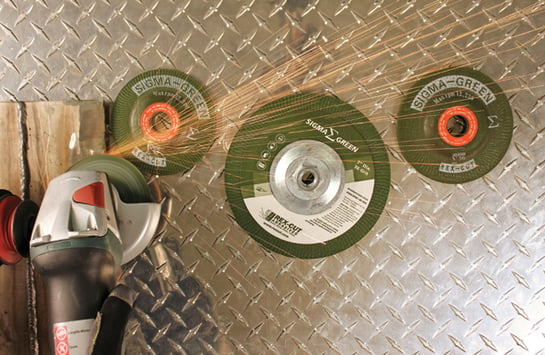COMBATING VIBRATION:
Hand/Arm Vibration Syndrome is driving changes in the workplace, with specific implications for workers that use powered hand tools like grinders. The European Union has put a standard into place stating that if any tool/accessory wheel combination has a vibration rate over 5 m/s2, then operation of that unit must be limited. When an operator uses the unit, time must be logged and when the threshold is reached, the operator must stop using the tool and transition to other work.
The Occupational Health and Safety Administration (OSHA) is now looking at mitigating hand/arm vibration syndrome here in the U.S. It’s for good reason, considering this is a serious neurological and circulatory condition, identified by numbness and pain in the fingers, with the fingers actually changing color in severe circumstances.
When a similar body, the National Institute for Occupational Safety and Health (NIOSH) first warned of this condition, it also recommended, among other measures, that vibrating tools such as grinders be redesigned to minimize vibration[1]. Grinder manufacturer Metabo is working to reduce vibration through the addition of innovative technologies such as an autobalancer to stabilize grinding discs spinning up to 11,000 rpm. When you consider the impact of such a high speed, even minor improvements can make a major difference in vibration reduction.
REDUCING VIBRATION INCREASES LONGEVITY FOR BOTH OPERATOR AND EQUIPMENT:
Reducing vibration came with an unexpected surprise: Metabo found that by controlling vibration, their angle grinders lasted 50-100% longer before requiring maintenance. Carbon brush replacement time doubled from 100 to 200 hours, and common replaceable components such as ball bearings and motor windings also increased in longevity. This leads to significant reductions in maintenance costs for businesses using these tools.
And that was not the only discovery. Metabo contracted an engineering study that took high-speed film of grinding wheels under load. A wheel running on an angle grinder without an autobalancer and a wheel running on a Metabo angle grinder were compared. When the footage was slowed down, it was discovered that the wheel on the unbalanced grinder would jump repeatedly off the grinding surface and then return. This bouncing action reduces wheel life and can actually lead to a shattered grinding wheel, causing potential injury to the operator far above the damage of hand/arm vibration syndrome.
On the subject of grinding wheels, Terry Tuerk, Senior Product Manager for Metabo, highlighted another important factor in reducing vibration: “The quality of the manufacturer of the disc itself comes into play,” he stated. “Even if a grinder does not have an autobalancer, a near-perfect balanced disc will still outlast an out-of-balance disc. Wheels that are manufactured to low vibration specifications will also help protect the health of the operator, which is the most important benefit of using a low-vibration tool. The standards of the manufacturer are very important, and there’s no question that Rex-Cut is a very high quality manufacturer.”

According to OSHA, employers pay almost $1 billion per week in workers’ compensation costs. That doesn’t include the cost of lost productivity or litigation if it it can be shown that the employer did not take appropriate safety measures. Protecting employees by reducing vibration, and the chances of an instability related injury, should be considered vital by companies who regularly use hand held power tools during daily operations. The short-term savings realized by longer lasting equipment is immediately measurable, and the long-term savings in reducing injuries and down time can be felt for years to come.
GRINDING WHEEL SAFETY:
Find more information on safe grinding here.
[1] “Vibration Syndrome: Current Intelligence Bulletin 38,” National Institute for Occupational Safety and Health—The Centers for Disease Control and Prevention, (March 1983) , http://www.cdc.gov/niosh/docs/83-110/